
* While few would think of Switzerland as a major exporter of military aircraft, the Swiss have established what is close to a standard for military trainer aircraft in the form of the Pilatus "PC-7", "PC-9", and "PC-21" tandem-seat turboprop trainers. This document provides a history and description of the Pilatus turbo-trainers.
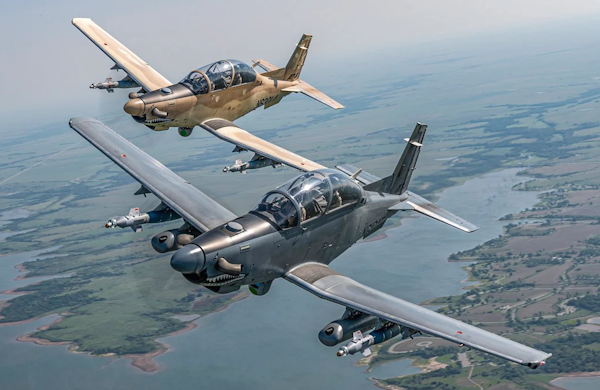
* The Swiss aviation firm Pilatus Flugzeugwerk AG was established at Stans in December 1939 as an element of the Oerlikon Buhrle group, and proceeded to design a light single-engine transport, the "SB-2 Pelican", which performed its first flight in 1944. Although the Pelican was not a commercial success, it would lead to much more successful Pilatus light transports.
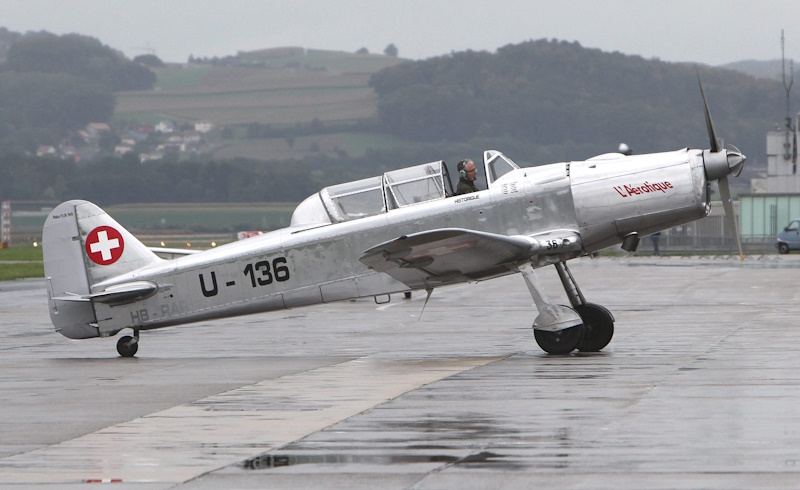
The company also pursued another line of development, focused on tandem-seat trainers, beginning with the "P-2", which first flew on 27 April 1945. It was a low-wing monoplane of mostly metal construction, with fabric-covered control surfaces, retractable taildragger landing gear, and an Argus AS-410A-2 12-cylinder, inverted vee, water-cooled engine with 347 kW (465 HP), obtained from Czechoslovakia. The P-2 was optimized for operations from high altitude airfields; it featured oxygen kit, radio, and night-flying instrumentation.
___________________________________________________________________
PILATUS P-2:
___________________________________________________________________
wingspan:
11.0 meters (36 feet 1 inch)
length:
9.07 meters (29 feet 9 inches)
height:
2.70 meters (8 feet 10 inches)
empty weight:
1,520 kilograms (3,350 pounds)
loaded weight:
1,970 kilograms (4,345 pounds)
max speed at altitude:
340 KPH (210 MPH / 180 KT)
range:
865 kilometers (535 MI / 465 NMI)
___________________________________________________________________
The P-2 had some resemblance to the Messerschmitt Bf 108 Taifun four-seat utility aircraft, but featured a tandem-seat cockpit with a jettisonable greenhouse-style canopy, and main gear that retracted from the wings toward the fuselage to give the machine a comfortable wide track on the ground. It was actually built with some assemblies from old Swiss Messerschmitt Bf-109 fighters.
A total of 54 P-2s was built, all serving with the Swiss Air Force, with half as "P-2.05" flight trainers, and half as "P-2.06" weapons trainers. The P-2.06 could be fitted with a machine gun, gunsight, gun camera, and underwing racks for rockets or light bombs for weapons training, and for observer training the back-seater was provided with a camera. The P-2 remained in service for decades, being finally withdrawn in 1981. Some linger on in private hands.
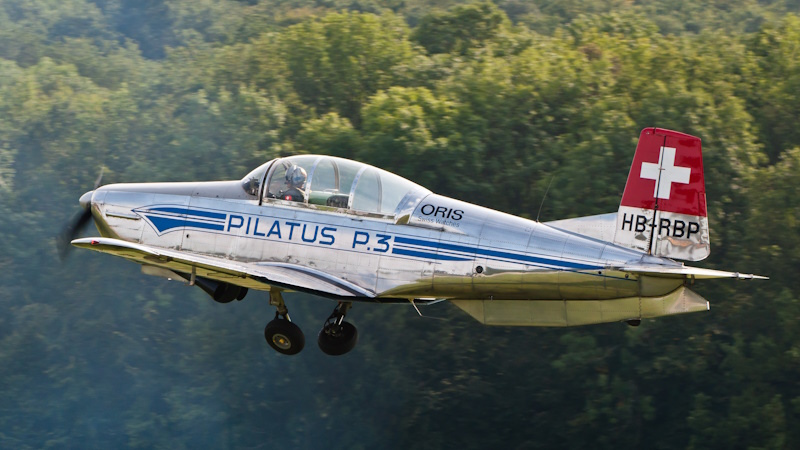
* The P-2 was a somewhat stodgy design that looked more like a prewar aircraft than a postwar aircraft. Pilatus decided to rethink the P-2 to bring it more up to date, resulting in the "P-3", which first flew on 3 September 1953, with test pilot Georg Gizler at the controls. The general configuration of the P-3 was similar to that of the P-2, the main differences being that the P-3 had tricycle landing gear and a sliding clearview canopy. The P-3 was substantially lighter than the P-2, and powered by a Lycoming GO-435-C2A piston engine with 195 kW (260 HP). Cockpit gear and optional weapons fit was similar to that of the P-2.
___________________________________________________________________
PILATUS P-3:
___________________________________________________________________
wingspan:
10.40 meters (34 feet 1 inch)
wing area:
16.55 sq_meters (178 sq_feet)
length:
8.75 meters (28 feet 8 inches)
height:
3.05 meters (10 feet)
empty weight:
1,110 kilograms (2,445 pounds)
loaded weight:
1,500 kilograms (3,310 pounds)
max speed at altitude:
310 KPH (190 MPH / 165 KT)
service ceiling:
5,485 meters (18,000 feet)
range:
750 kilometers (465 MI / 405 NMI)
___________________________________________________________________
72 P-3s were built for the Swiss Air Force, being used for both training and liaison duties, remaining in service to 1995. Six were also supplied to Brazil Navy in 1963, with five survivors passed on to the Brazilian Air Force in 1965. As with the P-2, some P-3s linger on in civilian hands.
BACK_TO_TOP* In the 1960s, Pilatus began to consider updating the P-3 into a much more formidable aircraft by fitting it with a turboprop engine. The first example, originally designated the "P-3B" and then the "PC-7 Turbo-Trainer", was the P-3 prototype re-engined with a Pratt & Whitney Canada (PWC) PT6A-20 turboprop engine providing 410 kW (550 SHP). It performed its first flight on 12 April 1966, but after it was damaged in a forced landing the company shelved the project, since there wasn't much apparent customer interest at the time.
It was revived in 1973, with Pilatus re-engining a Swiss Air Force P-3 with a PWC PT6A-25 turboprop engine, normally rated at 485 kW (650 SHP) but limited to 410 kW (550 SHP) and driving a Hartzell three-bladed propeller. This second prototype, designated the "PC-7 Turbo Trainer", performed its first flight on 12 May 1975, with test pilot Hans Galli at the controls. A second prototype with considerable improvements followed; the first production machine, again flown by Galli, took to the air on 18 August 1978.
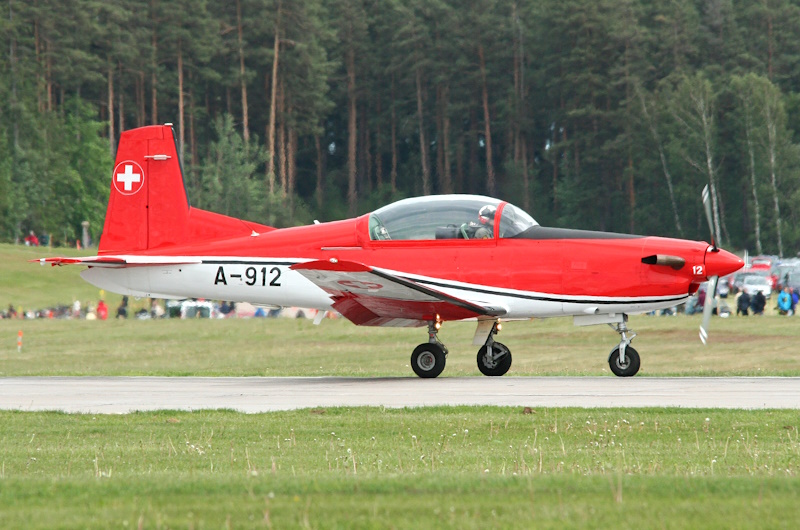
As it emerged, in comparison to the P-3 the PC-7 featured:
The cockpit was unpressurized and lacked ejection seats. The aircraft was unarmed, but had six underwing hardpoints for external loads of up to 1,040 kilograms (2,300 pounds). Dornier of Germany helped design the wing and landing gear.
___________________________________________________________________
PILATUS PC-7:
___________________________________________________________________
wingspan:
10.40 meters (34 feet 1 inch)
wing area:
16.6 sq_meters (179 sq_feet)
length:
9.77 meters (32 feet 1 inch)
height:
3.21 meters (10 feet 9 inch)
empty weight:
1,350 kilograms (2,980 pounds)
loaded weight:
2,700 kilograms (5,955 pounds)
max speed at altitude:
500 KPH (310 MPH / 270 KT)
take-off distance (to 15 meters / 50 feet):
590 meters (1,935 feet)
landing distance (from 15 meters / 50 feet):
625 meters (2,050 feet)
service ceiling:
10,000 meters (33,000 feet)
range:
1,350 kilometers (840 MI / 730 NMI)
___________________________________________________________________
The Swiss Air Force obtained 40 PC-7s in 1981, with final delivery in 1983. Late in the decade, a flight demonstration team was informally put together, leading to the introduction of the "PC-7 Team" in 1989. They fly nine PC-7s, eventually fitted with smoke generators, and continue to put on many flight displays.
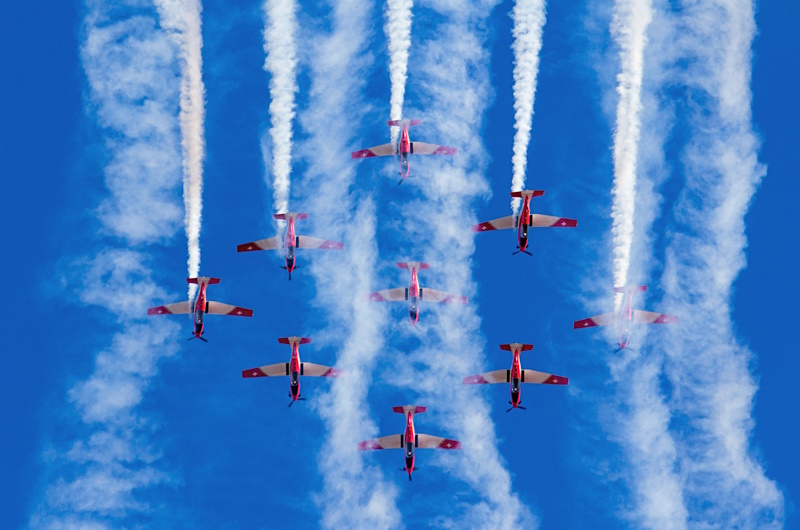
The PC-7 also proved very popular in the export market, since there was no real competition for it at the time. 455 were sold up to end of production in 2000, with customers including:
At least seven were sold to civil customers. In 1984, Pilatus offered as an option fit of Martin-Baker CH Mark 15A ejection seats, with an escape envelope ranging from ground and 110 KPH (60 knots) to maximum speed and altitude, and some PC-7 customers ordered the ejection seats as a retrofit.
BACK_TO_TOP* The success of the PC-7 led to the introduction of competition in the form of the Brazilian Embraer Tucano, which performed its first flight in 1980. That led Pilatus in turn to consider design of a "bigger and better" version of the PC-7. Development of the new aircraft began in 1982, with various new technologies evaluated on a PC-7 testbed. The new aircraft emerged as the Pilatus "PC-9", with the first of two prototypes performing its first flight on 7 May 1984 -- Galli being at the controls -- and the second following quickly afterward, on 20 July.
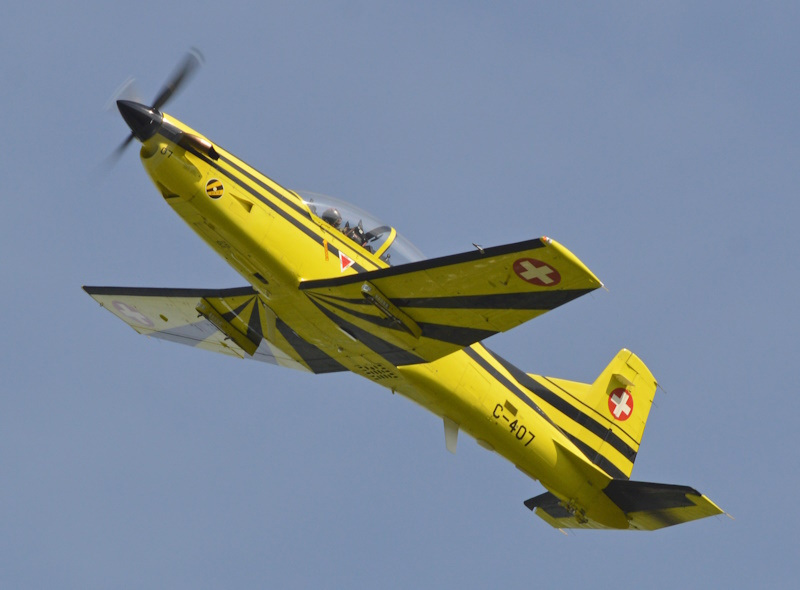
The PC-9 was offered for a British Royal Air Force competition to replace the Hunting Jet Provost trainer, Pilatus being partnered with British Aerospace (BAE) for the deal. Embraer won the competition in 1985 with the Tucano, but the BAE connection led to a large deal for 30 PC-9s with Saudi Arabia.
The PC-9 looked very much like a PC-7, though it was clearly larger and heavier, and had a distinctive stepped tandem cockpit with a raised canopy, giving the back-seater a much better forward view. The canopy hinged open to the right. The PC-9 had only about 10% commonality with the PC-7. The PC-9 was powered by a PWC PT6A-62 turboprop engine with 860 kW (1,150 SHP), downrated to 710 kW (950 SHP), driving a four-bladed Hartzell propeller. The cadet and flight instructor sat on Martin-Baker Mark CH11A ejection seats, ejecting through the canopy. The machine was fitted with hydraulically-operated landing gear and a hydraulically-operated ventral airbrake. The PC-9 retained the six underwing hardpoints of the PC-7, with the inner two being "wet" for carriage of 145-liter (41 US gallon) or 248-liter (66 US gallon) external tanks.
___________________________________________________________________
PILATUS PC-9:
___________________________________________________________________
wingspan:
10.19 meters (33 feet 5 inches)
wing area:
16.28 sq_meters (175 sq_feet)
length:
10.14 meters (33 feet 4 inches)
height:
3.26 meters (10 feet 8 inches)
empty weight:
1,725 kilograms (3,805 pounds)
loaded weight:
3,200 kilograms (7,055 pounds)
max speed at altitude:
665 KPH (415 MPH / 360 KT)
take-off distance (to 15 meters / 50 feet):
645 meters (2,115 feet)
landing distance (from 15 meters / 50 feet):
925 meters (3,035 feet)
service ceiling:
11,580 meters (38,000 feet)
range:
1,540 kilometers (955 MI /830 NMI)
___________________________________________________________________
The Swiss Air Force didn't buy the PC-9 for training, but did obtain 12 for use as target tugs, fitted with a Southwest RM-24 winch system under each inner wing. These machines could also be used for electronic countermeasures training, carrying an Ericsson EriJammer A100 jamming pod, known as the "Vista 5" pod in Switzerland.
Export sales were excellent. By 1998, Pilatus had sold a total of almost 240 PC-9s, with customers including:
Seven were sold to unknown customers. Later production had a larger dorsal fin to improve yaw stability; modified wingroot fairings; stall strips on the wing leading edges; and updated engine and propeller controls.
* In 1992, Pilatus introduced a "PC-7 Mark II" for a South African trainer competition to replace the country's 50-year-old North American Harvards. The South Africans wanted something better than the PC-7, but not as formidable as the PC-9 -- and despite the PC-7 designation, the Pilatus offering was essentially a low-budget PC-9, with a PT6A-25C engine providing 635 kW (850 SHP) downrated to 520 kW (700 SHP) and driving a four-bladed propeller. The PC-7 Mk.II had only two underwing hardpoints. The only particularly noticeable recognition feature of the PC-9 Mark II versus the PC-9 was a larger tailfin fillet, but it did feature changes under the skin, such as improved avionics and an on-board oxygen generation system (OBOGS).
Two prototypes of the PC-7 Mark II were built, with the first performing its initial flight on 18 September 1992. The type won the South African competition in early 1993, and the first production aircraft flew in August 1994, with delivery to the South African Air Force in November 1994. 60 were handed over into 1996, with the aircraft assembled locally from kits. From 2009, 35 of the South African machines were upgraded with improved avionics by Pilatus, the primary goal being to provide the aircraft with a modern "glass cockpit".
___________________________________________________________________
PILATUS PC-7 MARK II:
___________________________________________________________________
wingspan:
10.19 meters (33 feet 5 inches)
wing area:
16.28 sq_meters (175 sq_feet)
length:
10.14 meters (33 feet 4 inches)
height:
3.26 meters (10 feet 8 inches)
empty weight:
1,670 kilograms (3,685 pounds)
loaded weight:
3,200 kilograms (6,285 pounds)
max speed at altitude:
555 KPH (480 MPH / 415 KT)
take-off distance (to 15 meters / 50 feet):
785 meters (2,575 feet)
landing distance (from 15 meters / 50 feet):
890 meters (2,920 feet)
service ceiling:
9,150 meters (30,000 feet)
range:
1,500 kilometers (930 MI / 810 NMI)
___________________________________________________________________
Other customers for the PC-7 Mark II included:
* Following the introduction of the PC-9 Mark II, Pilatus introduced the "PC-9M", where "M" stood for "modular". It featured the tailfin fillet and OBOGS system of the PC-9 Mark II, along with updated avionics -- a "glass cockpit" with main and secondary multifunction displays (MFDs), Global Position System (GPS) navigation, and an optional head-up display (HUD) for the front-seater; when the HUD was fitted, the back-seater had a repeater display.
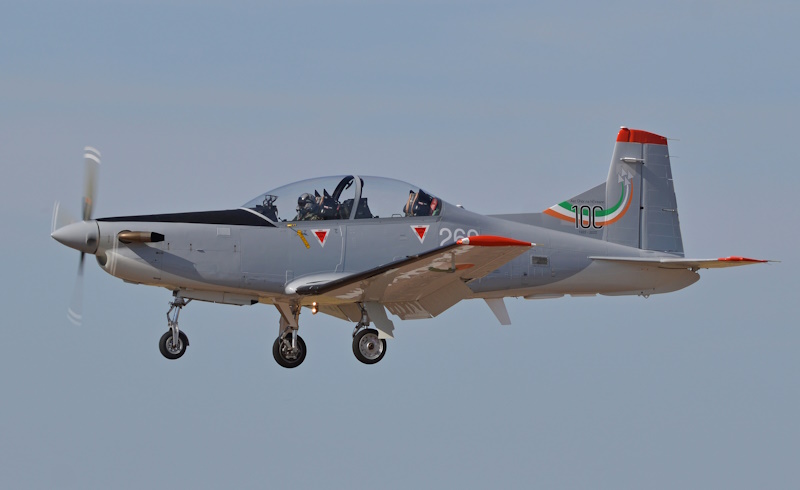
Customers included:
The PC-9M was used as the basis for the Beechcraft "T-6A Texan II", the winning candidate for the US military's "Joint Primary Air Trainer System (JPATS)", intended to provide flight training for the US Air Force and Navy. JPATS was conceived by the Pentagon in the late 1980s, leading to a preliminary request in 1990. Beech Aircraft came to an agreement with Pilatus to obtain and modify the PC-9 design for JPATS, receiving two "stock" PC-9s, one in August 1990 and the other in March 1991, for development. The second PC-9 was gradually modified to incorporate new features, leading to the construction of two new-build JPATS prototypes. The first flew in December 1992, followed by the second in July 1993. The second new-build prototype was used in the JPATS evaluation.
The flight evaluation was performed from July through October 1994 at Wright-Patterson Air Force Base in Ohio. The Beech entry seemed like a dark-horse candidate, the service bias being to obtain a pure-jet trainer to prepare pilots for jet operations -- but it was declared the winner of the competition on 22 June 1995. Other manufacturers engaged in the competition submitted legal protests; they were ultimately rejected, but it took some time, and so the actual development contract wasn't signed until 5 February 1996.
The JPATS contract involved development of both the aircraft and a ground-based training system, which included flight simulators, training kit, a management and support system, and instructional courseware. A subcontract for the ground system was awarded to Flight Safety Services Corporation in April 1997 by Raytheon, which had bought out Beech in the interim. The company was known as "Raytheon Aircraft", but for simplicity, it's called "Beechcraft" here, the old Beech organization retaining its identity.
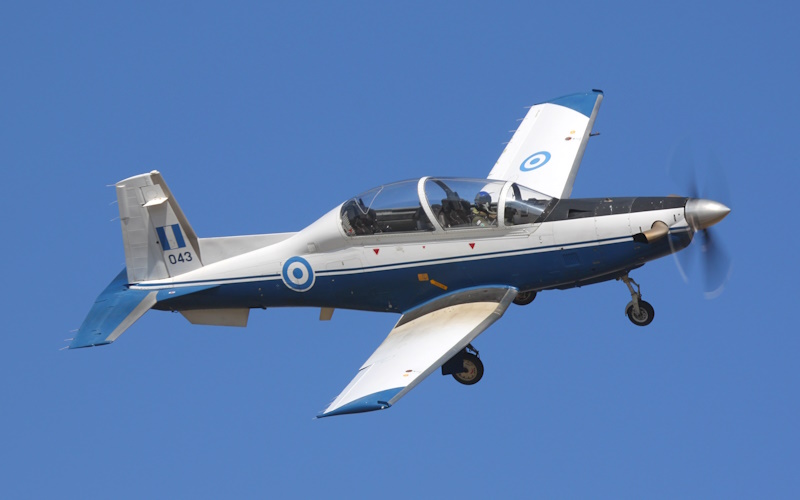
Manufacture of the T-6A began in February 1997, with the first production aircraft rolled out at the Beech plant in Wichita, Kansas, on 29 June 1998. It performed its first flight on 15 July 1998. The T-6A received US Federal Aviation Administration (FAA) certification on 20 August 1999. Initial deliveries to the USAF took place the same year, with deliveries to the US Navy following.
The T-6A looked clearly like a PC-9M externally, the only immediately visible change being a separate windscreen, but it was very much different in detail, with only about 30% commonality with the PC-9M. It had a strengthened fuselage; pressurized cockpit; and modernized avionics, including GPS, a collision avoidance system, and provision for a HUD. It was powered by a PWC PT6A-68 turboprop engine, normally rated at 1,275 kW (1,708 SHP) but limited to 820 kW (1,100 SHP), driving a four-bladed Hartzell propeller. It had three hardpoints under each wing.
___________________________________________________________________
RAYTHEON T-6A TEXAN II:
___________________________________________________________________
wingspan:
10.15 meters (33 feet 4 inches)
wing area:
16.28 sq_meters (175 sq_feet)
length:
10.14 meters (33 feet 4 inches)
height:
3.26 meters (10 feet 8 inches)
empty weight:
2,087 kilograms (4,600 pounds)
loaded weight:
2,857 kilograms (6,300 pounds)
max speed at altitude:
575 KPH (360 MPH / 310 KT)
take-off distance (to 15 meters / 50 feet):
610 meters (2,000 feet)
landing distance (from 15 meters / 50 feet):
732 meters (2,400 feet)
service ceiling:
10,670 meters (35,000 feet)
range:
1,574 kilometers (980 MI / 850 NMI)
___________________________________________________________________
Development of the Texan II proved anything but smooth, but the problems were ironed out, and the aircraft was finally approved for full production in late 2001. Total production for the US military was 748 machines, including 454 for the US Air Force, with the last delivered in 2010; 295 for the US Navy, the last delivered in 2016; and four for the US Army, delivered in 2015. In 2007, Raytheon Beechcraft became "Hawker Beechcraft", to then become "Textron Beechcraft" in 2014. Again, the Beechcraft name is used here for simplicity.
All the USAF machines were T-6As. The first 43 Navy machines were T-6As, but the following 252 were "T-6Bs", with "hands on throttle and stick (HOTAS)" controls, and a "glass cockpit" with a widescreen HUD plus three 12.7 x 17.8 centimeter (5 x 7 inch) MFDs. It also had maximum take-off weight increased by 180 kilograms (400 pounds).
Along with the T-6B, Beech offers a "T-6C" that adds underwing stores capability, mostly for carriage of external tanks, the focus being on export sales. The US Army machines are modified T-6Cs, known as "T-6Ds", these aircraft being used as chase planes, and for other support roles.
Beech has also developed an "AT-6" light attack / armed reconnaissance variant of the Texan II, which acquired the name of "Wolverine". It had a centerline stores pylon and three stores pylons under each wing, for a total of seven; cockpit and engine armor; night vision goggle (NVG) compatible cockpit; a reinforced airframe to handle higher take-off weight; and combat avionics including helmet-mounted sight, datalinks, defensive countermeasures, and an electro-optic / infrared imager turret mounted on the centerline. The turret included a laser designator and rangefinder capability as well.
The AT-6 had the digital cockpit of the T-6B, and featured a mission system / central control unit, derived from the A-10C "Warthog" close support aircraft and supplied by Lockheed Martin. Production machines were fitted with the PT6A-68D engine providing 1,190 kW (1,600 SHP).
The AT-6 was announced in 2006, the sales prospect being the Iraqi Air Force. Initial flight of a prototype was in September 2009 -- not long after the announcement of a fast-track Pentagon requirement for a hundred light attack machines based on an off-the-shelf solution, which no doubt raised the priority of the AT-6 program considerably. That program went through a number of gyrations, the end result being 20 Embraer Super Tucanos being bought for the Afghan Air Force, with other orders possible. Beech protested the award, but the protest was rejected. The first production AT-6 -- originally named the "Coyote", but then renamed "Wolverine" -- performed its initial flight in August 2013.
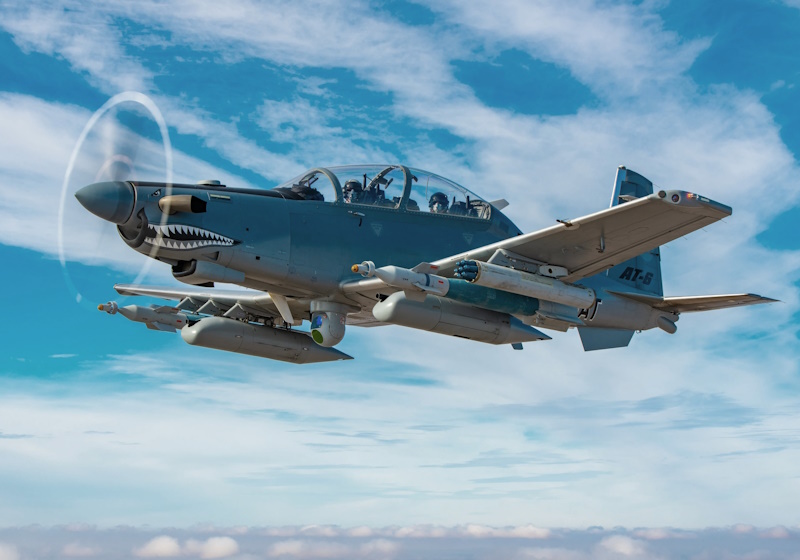
* Beech pays a royalty to Pilatus for each Texan II, but also competes with Pilatus in the export market, and has scored a number of wins:
In the spring of 2020, the USAF ordered two AT-6Cs and two Embraer A-29 Super Tucanos, comparable to the AT-6, from Textron and Sierra Nevada respectively. They were intended to support the Air Force's light-attack effort, in support of foreign allies. It appears these machines were in particular intended to evaluate battlefield aerial relay systems. These were the only AT-6s to be sold so far, with the evaluation not leading to further purchases. It appears interest in light attack has moved on to turboprop cropduster aircraft adapted to the attack role, and drones.
BACK_TO_TOP* In November 1998, no doubt with competition from Beechcraft in mind, Pilatus began studies for a PC-9 follow-on that could provide comprehensive training, from basic flight instruction to lead-in fighter training, and would be more reliable, easier to maintain, and cheaper to operate than its predecessors. That led to initiation of a full development program using company funds in January 1999. The new machine, the "PC-21", was basically a complete facelift of the PC-9 with improved systems and many airframe changes. A PC-7 Mark II was used to validate some of the technologies for the new machine.
The PC-21 looked much like the PC-9, but there were significant differences. The PC-21 was fitted with a PWC PT6A-68B turboprop engine with 1,195 kW (1,600 SHP), driving a five-bladed graphite composite scimitar propeller, and featured a wing with a swept leading edge for higher performance.
The PC-21 had HOTAS controls, as well as a state-of-the-art "glass cockpit", with three 15 by 20 centimeter (6 by 8 inch) LCD panels and two smaller LCD panels for both cadet and flight instructor, plus a HUD in the front cockpit. The rear cockpit could be fitted with a HUD repeater panel. The cockpit displays and controls were compatible with NVGs. The PC-21's digital flight-control system could be programmed to limit performance and functionality as appropriate to the level of training, providing modest performance and functionality for basic flight instruction and full functionality for lead-in fighter training. The cadet could select a "full flight safety" mode in an emergency.
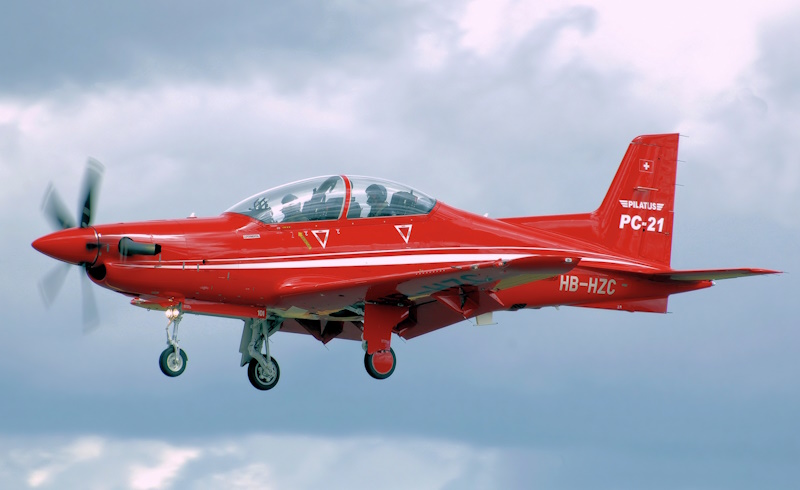
The flight system provided a radar emulator and even a weapons drop emulator, simulating release of ordnance and providing a score. Digital recorders tracked all activity, including display outputs, during a training flight for debriefing afterward. Other innovations included a pressurized cockpit, Martin-Baker Mark 16L zero-zero ejection seats, and an OBOGS. The PC-21 could carry a fair maximum external load of 1,150 kilograms (2,535 pounds) on five external hardpoints.
___________________________________________________________________
PILATUS PC-21:
___________________________________________________________________
wingspan:
8.77 meters (28 feet 9 inches)
wing area:
15.22 sq_meters (164 sq_feet)
length:
11.0 meters (36 feet 1 inch)
height:
4.0 meters (13 feet 1 inch)
empty weight:
2,250 kilograms (4,960 pounds)
loaded weight:
4,250 kilograms (9,370 pounds)
cruise speed:
685 KPH (425 MPH / 370 KT)
service ceiling:
11,580 meters (38,000 feet)
range:
1,335 kilometers (830 MI / 720 NMI)
___________________________________________________________________
The first PC-21 prototype performed its initial flight on 1 July 2002, with test pilot Bill Tyndall at the controls. A second prototype followed on 7 June 2004, though it was lost in an accident on 13 January 2005 that killed test pilot Andy Ramseier. Two more prototypes, built up to full specification, performed their initial flights in 2005 and 2006 respectively. Orders have been coming in:
* Sources include:
I roughed out the document using downloads from the German FLUG REVUE website.
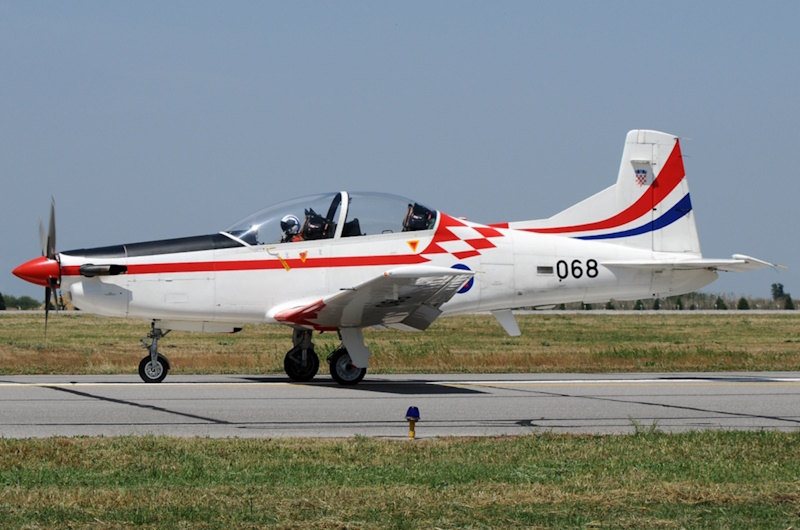
* Illustration credits:
* Revision history:
v1.0.0 / 01 sep 07 v1.0.1 / 01 aug 09 / Review & polish. v1.0.2 / 01 jul 11 / AT-6 details. v1.0.3 / 01 jan 13 / Saudi & Qatari PC-21 orders. v1.0.4 / 01 jun 13 / Botswana PC-7-IIs. v1.0.5 / 01 may 15 / Production AT-6 flies. v1.1.0 / 01 apr 17 / More on T-6, PC-21. v1.1.1 / 01 mar 19 / Review, update, & polish. v1.1.2 / 01 feb 21 / Review, update, & polish. v1.2.0 / 01 jan 23 / Format change. v1.3.0 / 01 jan 25 / Illustrations update.BACK_TO_TOP
